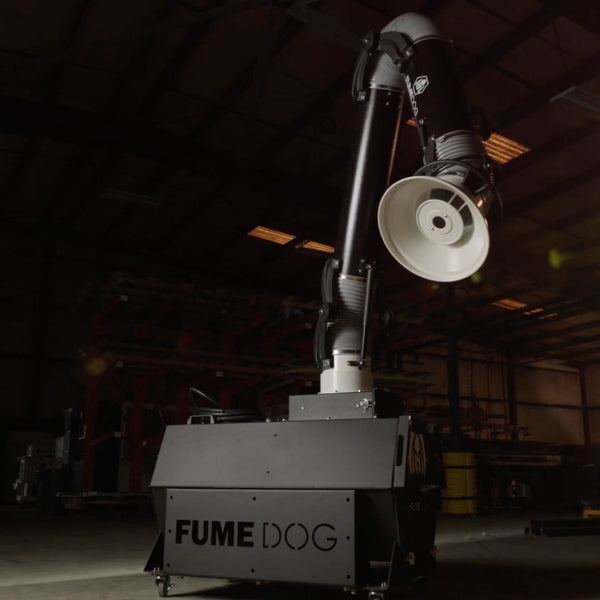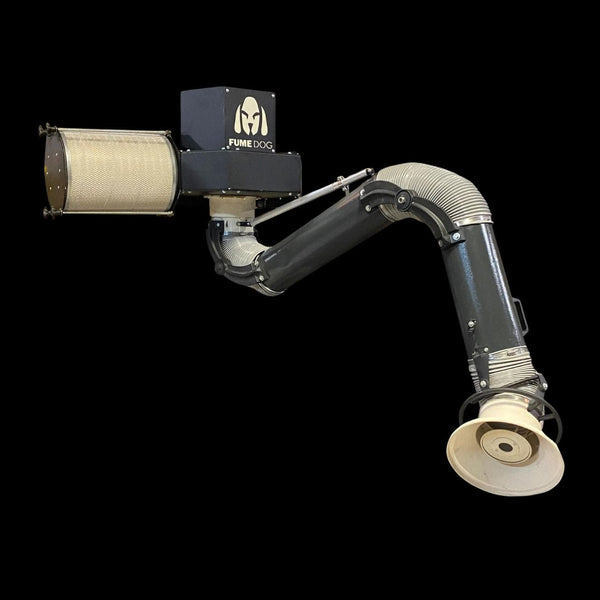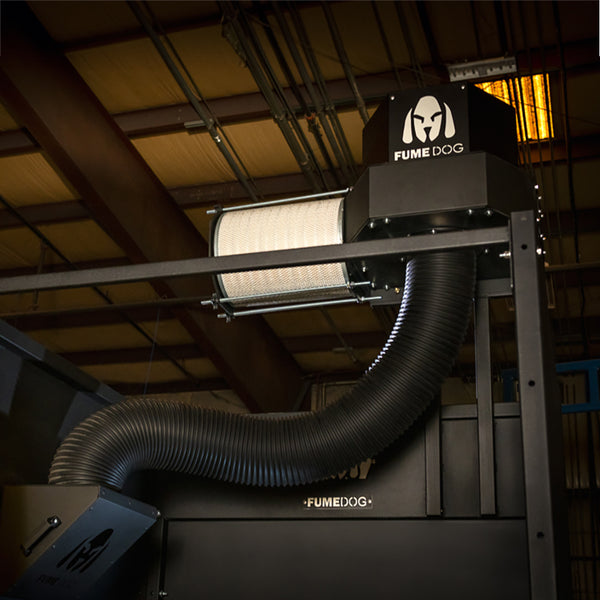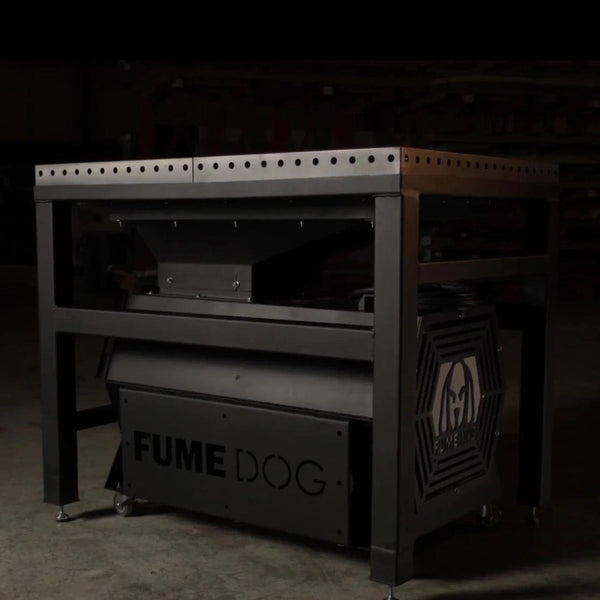Are you new to the world of welding and struggling to understand TIG welding and how it works? Don’t stress; we at Fume Dog are here to clear the air- quite literally! TIG welding, also called gas tungsten arc welding, is a precise and versatile method for joining metals. If that doesn’t make too much sense, the following guide should help you to understand the TIG welding process, its benefits, and where it’s commonly used.
Keep reading to learn more about this high-quality welding technique!
What is TIG Welding?
TIG welding, short for “tungsten inert gas welding”, uses a non-consumable tungsten electrode to create a precise and controlled welding arc. This method relies on shielding gas, like argon or helium, to protect the weld pool from atmospheric contamination.
A TIG welder may add filler metal manually using a filler rod for thicker materials, while thinner metals can often fuse without it. Either way, the process works well with various metals, such as steel and aluminum, producing high-quality welds with minimal spatter.
How Does TIG Welding Work?
Put simply, TIG welding uses a tungsten electrode to create an electric arc. This arc melts the metal and forms a weld puddle, which can be manually fed with filler material for stronger joints. However, let’s dive into the process with a little more detail.
Essential Components of a TIG Welder
A TIG welder includes several essential parts that work together to create high-quality welds:
-
The TIG torch holds a non-consumable tungsten electrode, which produces the arc needed to melt the metal.
-
A power source provides either AC welding or DC welding, depending on the material being joined. Steel generally uses DC welding, while aluminum often requires AC welding.
-
Shielding gas protects the weld puddle from contamination by enveloping it in an inert atmosphere. Argon is commonly used because of its stability and effectiveness. A filler rod can be added manually based on your project requirements or omitted for autogenous welds.
-
Foot pedals or hand controls offer precise heat regulation during operation, ensuring clean and strong results every time.
The TIG Welding Process Explained
As we briefly touched on previously, TIG welding uses a non-consumable tungsten electrode to produce an electric arc. This arc creates intense heat, which melts the base metal and forms a weld pool. A welding torch holds the electrode while shielding gas keeps the weld area safe from contamination.
Operators can adjust the heat using a foot pedal or fingertip controls on the TIG machine. The process demands steady hands for accurate and high-quality welds. It works effectively with materials like aluminum, steel, and exotic alloys that need precision welding.
Role of Shielding Gas
Shielding gas is a very important part of the TIG welding process, as it protects the welding area from contamination. It blocks oxygen, nitrogen, and hydrogen in the air from damaging the weld quality.
Furthermore, inert gases like argon or helium help create a stable arc and improve accuracy during TIG welding. When welding steel or aluminum with TIG, shielding gases ensure strong welds without oxidation or porosity problems.
Advantages of TIG Welding
There are many advantages to TIG welding over MIG welding, primarily because it delivers precision and clean results across various metal types—read on to understand why this is.
High Precision and Control
TIG welding provides exceptional precision and control compared to MIG welding. The non-consumable tungsten electrode allows operators to produce high-quality welds. Professionals can easily adjust the heat and arc for detailed projects, especially when working with steel or aluminum.
As a result, this process excels in handling complex designs and tight tolerances. Using a TIG welding system ensures greater accuracy compared to other methods like shielded metal arc welding or MIG welding. It truly does help industrial workers achieve flawless results while maintaining durability.
Clean and Strong Welds
Another benefit of TIG welding is that it produces high-quality welds with minimal to no spatter. The non-consumable tungsten electrode provides precision, creating clean joins without any contamination. Using an inert gas like argon prevents oxidation and protects the weld area.
This method forms strong bonds by fusing metals at higher temperatures. Also, TIG welding steel or aluminum creates durable connections that hold up against wear and tear over time. Professionals in various industries count on these flawless finishes for critical projects that demand perfection.
Versatility Across Metals
You may have realized by now that TIG welding works well with different metals, such as aluminum, stainless steel, and copper. It uses a non-consumable tungsten electrode that offers control for detailed projects needing precision, which is pretty invaluable. Most importantly, welders can adjust the heat and shielding gas to match specific materials.
Overall, this method creates strong, high-quality welds on both thin and thick surfaces. It doesn’t matter whether you’re fixing an engine block or creating artistic designs–the versatility of TIG welding makes it highly suitable.
Common TIG Welding Applications
So, what exactly can TIG welding be used for in the workspace? Well, it delivers precision for all sorts of demanding industries, primarily playing a key role in creating custom and durable metalwork for the following use cases.
Aerospace and Aviation
Aerospace and aviation industries demand high precision, and therefore, TIG welding is essential. It creates strong, clean welds, which are necessary for safety-critical components such as jet engines and fuselages.
Many aerospace alloys, including aluminum and titanium, require TIG welding. Its ability to create high-quality welds without compromising the material's strength makes it invaluable. Overall, professionals in these industries depend on this method because of its precise heat control and versatility across different metals.
Automotive Industry
In the automotive industry, TIG welding plays an important role as it delivers high-quality welds for crucial components. It offers precise control and clean finishes, making it perfect for assembling frames, exhaust systems, and fuel tanks.
The non-consumable tungsten electrode used in TIG welding ensures durability during demanding applications. What’s more, shielding gas prevents contamination, which is critical for maintaining safety standards in vehicles.
Artistic and Custom Fabrication
While it might not sound quite as important as aerospace, aviation, and automotive industries, artistic and custom fabrication jobs depend on high-quality welds for unique designs. TIG welding is ideal here, providing the precision necessary to create intricate patterns and structures. Its versatility with different metals, like aluminum, makes it essential for crafting sculptures or custom metalwork.
Conclusion
The bottom line here is that TIG welding stands out for its precision and versatility when compared to MIG welding. It creates high-quality welds on a wide range of metals, including aluminum, so professionals value it for clean, strong results and excellent control.
For safe welding environments, Fume Dog has you covered with top-notch fume extraction solutions. Keep your workspace clean while perfecting your craft by checking out our products today!
FAQs
What is TIG welding?
TIG welding, also known as gas tungsten arc welding or tungsten inert gas welding, is a precise method of welding where an arc is formed between a tungsten electrode and the metal being welded. It's ideal for intricate work and high-quality welds.
How does the TIG welding process work?
In the TIG welding process, an inert gas shields the weld pool from contamination, ensuring clean and strong welds. Heat is controlled precisely, which makes it suitable for welding aluminum and other sensitive metals.
What is the difference between TIG welding and MIG welding?
TIG welding offers precise, high-quality welds by manually feeding filler metal into the weld pool, making it great for detailed work. MIG welding, or metal inert gas welding, uses automatically fed filler material and is faster, better suited for large-scale jobs.
Do I always need filler material in TIG welding?
No, not always. While filler metal is commonly used to strengthen the weld, TIG welding can sometimes fuse metal pieces directly without additional filler material, especially when joining thinner metals or edges.
Why is inert gas used in TIG welding?
Inert gas like argon protects the weld pool from contaminants like oxygen and nitrogen. This prevents oxidation and ensures a stronger, cleaner weld.
Which metals are ideal for TIG welding?
TIG welding is versatile and particularly excellent for welding aluminum, stainless steel, copper, and other thin, delicate materials. It's one of the preferred welding processes for projects that require precise, aesthetically pleasing results.





